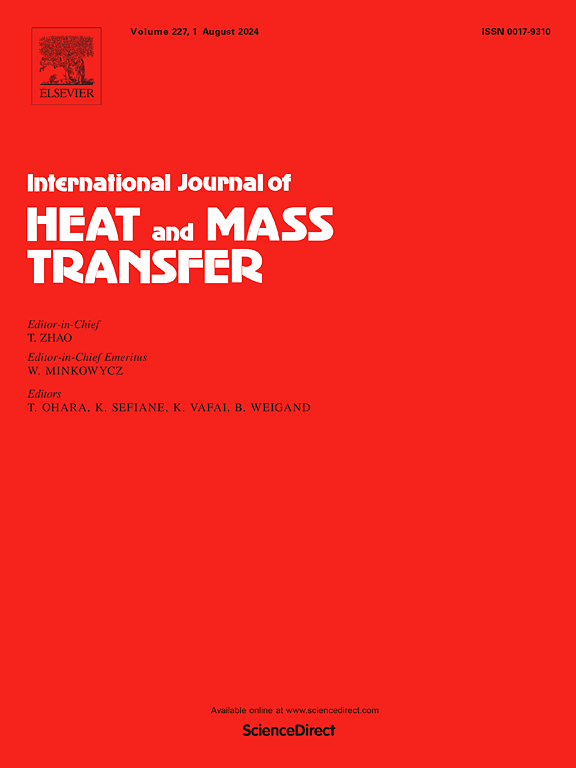A unified numerical framework for quantifying diffusion behavior in TPMS structures for solar thermochemical applications
IF 5
2区 工程技术
Q1 ENGINEERING, MECHANICAL
International Journal of Heat and Mass Transfer
Pub Date : 2025-06-27
DOI:10.1016/j.ijheatmasstransfer.2025.127434
引用次数: 0
Abstract
This study investigates the effective diffusion coefficient in Schwarz-P triply periodic minimal surface structures across the continuum, transition, and Knudsen regimes. A hybrid numerical approach, combining finite volume methods and random walk simulations, is utilized to assess how geometric parameters (power, curvature, and periodicity) affect porosity, tortuosity, specific surface area, and diffusion behavior at both macro and micro scales. In the continuum regime, the effective diffusion coefficient is primarily influenced by porosity and tortuosity. Structures with odd power values show reduced pore connectivity and porosity with increasing power or curvature, leading to decreased diffusion coefficients. Even power values result in dual-pore configurations that maintain higher porosity and specific surface area, with diffusion behavior mainly affected by throat dimensions. At the microscale, increasing periodicity reduces pore and throat sizes, prompting a transition from continuum to non-continuum transport behavior. The study also analyzes the sensitivity of the effective diffusion coefficient to pressure and temperature. In the continuum regime, the diffusion coefficient increases with decreasing pressure, while in the Knudsen regime, it becomes pressure-independent. Elevated temperatures enhance the diffusion coefficient across all regimes, with a more pronounced effect in the continuum regime. These findings provide a framework for optimizing triply periodic minimal surface-based porous media to improve gas-phase diffusion, with practical implications for enhancing the efficiency of solar thermochemical reactors.
太阳热化学应用中TPMS结构中扩散行为量化的统一数值框架
本研究探讨了Schwarz-P三周期最小表面结构在连续体、过渡和Knudsen体系中的有效扩散系数。结合有限体积法和随机游走模拟的混合数值方法,用于评估几何参数(功率、曲率和周期性)在宏观和微观尺度上对孔隙度、弯曲度、比表面积和扩散行为的影响。在连续介质状态下,有效扩散系数主要受孔隙度和弯曲度的影响。奇数功率值的结构随着功率或曲率的增加,孔隙连通性和孔隙率降低,导致扩散系数降低。即使是功率值也会导致双孔结构,从而保持更高的孔隙率和比表面积,而扩散行为主要受喉部尺寸的影响。在微观尺度上,周期性的增加减小了孔隙和喉道的尺寸,促进了从连续向非连续输运行为的转变。研究还分析了有效扩散系数对压力和温度的敏感性。在连续介质状态下,扩散系数随压力的减小而增大,而在Knudsen状态下,扩散系数与压力无关。高温提高了所有型态的扩散系数,在连续型态的影响更为明显。这些发现为优化三周期最小表面基多孔介质以改善气相扩散提供了一个框架,对提高太阳能热化学反应器的效率具有实际意义。
本文章由计算机程序翻译,如有差异,请以英文原文为准。
求助全文
约1分钟内获得全文
求助全文
来源期刊
CiteScore
10.30
自引率
13.50%
发文量
1319
审稿时长
41 days
期刊介绍:
International Journal of Heat and Mass Transfer is the vehicle for the exchange of basic ideas in heat and mass transfer between research workers and engineers throughout the world. It focuses on both analytical and experimental research, with an emphasis on contributions which increase the basic understanding of transfer processes and their application to engineering problems.
Topics include:
-New methods of measuring and/or correlating transport-property data
-Energy engineering
-Environmental applications of heat and/or mass transfer

 求助内容:
求助内容: 应助结果提醒方式:
应助结果提醒方式:


